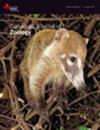宾夕法尼亚州三种中型食肉动物体内抗凝血灭鼠剂的空间模式
IF 1.1
4区 生物学
Q3 ZOOLOGY
引用次数: 0
摘要
人类对自然环境的影响现在无处不在,但根据当地环境和社区的不同,其表现形式也多种多样、各具特色。试图控制或调解当地害虫对住宅或农业的影响可能会对系统造成重要的负面影响。二次接触抗凝血杀鼠剂(ARs)会对野生食肉动物造成许多不利影响,包括死亡。我们假设,在宾夕法尼亚州各地的中食肉动物群落中都会发现抗凝血杀鼠剂,而在高度城市化或农业景观中的检出率最高。从 2019 年到 2022 年初,我们收集了山猫(Lynx rufus (Schreber, 1777))、鱼凫(Pekania pennanti (Erxleben, 1777))和河獭(Lontra canadensis (Schreber, 1777))三种食肉动物的尸体以获得肝脏样本(n=265)。我们使用广义线性模型来检验不同物种和空间尺度(包括宾夕法尼亚州狩猎委员会的六个区域和 23 个野生动物管理单位)之间 AR 检测率的差异。我们在所有物种(合计 44.2%)中都检测到了 AR,但不同物种的检测率有所不同。我们的研究是首次记录北美河獭体内的 ARs。本文章由计算机程序翻译,如有差异,请以英文原文为准。
Spatial patterns of anticoagulant rodenticides in three species of medium-sized carnivores in Pennsylvania
Human influences on natural environments are now ubiquitous but manifest in multiple and unique ways depending on local environments and communities. Attempts to control, or mediate, local pests to residences or to agriculture can impart important negative consequences on systems. Secondary exposure to anticoagulant rodenticides (ARs) can cause numerous adverse effects on wild carnivores including death. No studies have quantified AR prevalence, investigated their pathway of exposure, or associations with specific location types in the northeastern U.S. We hypothesized that ARs would be found in the mesocarnivore community throughout Pennsylvania and have the greatest detection rate in highly urbanized or agricultural landscapes. From 2019 through early 2022 we collected carcasses to obtain liver samples (n=265) from three species of carnivores: bobcats (Lynx rufus (Schreber, 1777)), fishers (Pekania pennanti (Erxleben, 1777)), and river otters (Lontra canadensis (Schreber, 1777)). We used generalized linear models to test for differences in AR detection rated among species and spatial scales including the six Pennsylvania Game Commission regions and 23 Wildlife Management Units. We detected ARs in all species (44.2% collectively), but detection rates differed among species. Our study is the first to document ARs within North American river otters.
求助全文
通过发布文献求助,成功后即可免费获取论文全文。
去求助
来源期刊

Canadian Journal of Zoology
生物-动物学
CiteScore
2.40
自引率
0.00%
发文量
82
审稿时长
3 months
期刊介绍:
Published since 1929, the Canadian Journal of Zoology is a monthly journal that reports on primary research contributed by respected international scientists in the broad field of zoology, including behaviour, biochemistry and physiology, developmental biology, ecology, genetics, morphology and ultrastructure, parasitology and pathology, and systematics and evolution. It also invites experts to submit review articles on topics of current interest.
 求助内容:
求助内容: 应助结果提醒方式:
应助结果提醒方式:


